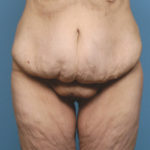
Whether the weight loss is from heroic dieting efforts or bariatric surgery, the damage that has been inflicted on the skin is irreversible. Once the skin appears taut when fully inflated (high weight), the loss of the underlying fat support causes a deflation of the skin cover much like the deflation of a balloon. The skin does not ‘snap back’ for two reasons which is identical to what can occur from pregnancy. First, the slow (or rapid) expansion of fat and weight stretches the skin and, in fact, actually makes more skin as it expands. This is well known in plastic surgery as an older, but still useful, surgical technique known as tissue expansion. (commonly used today in breast reconstruction after cancer) The slow stretching of skin, while causing it to thin somewhat, actually makes more surface area of skin. Secondly, stretching beyond a certain point causes the elastic fibers in the skin to become permanently deformed. The elastic fibers (and collagen) are responsible for skin’s elasticity. Like overstretching a spring, the fibers are pushed beyond their tensile limits and they are no longer able to return to their original coiled shape. The combination of more skin that is no longer elastic results in hanging sagging skin.
There are other factors which can make the loose skin condition better or worse. How much weight is lost, how rapid the weight loss has been, your type of skin (thinner more fair skin stretches more), your age (older patients develop more loose skin), and smoking (smoking breaks down elastic fibers faster) are all contributing factors as well. Clearly, large amounts of weight loss over a short period of time in an older patient with fair skin who smokes does not bode well for skin readaptation.
Unfortunately, no amount of dieting, exercise, or topical creams will restore the elasticity of skin. Simply put, excess skin must be cut out and the skin left behind tightened. This often leaves remaining stretch marks (if present before surgery) and, with time after surgery, there will be some relaxation of the remaining skin which has been tightened. But this small amount of relapse is trivial compared to the size of the original problem. This is where the role of bariatric plastic surgery comes in…to help do what your stretched out skin can not.
Dr. Barry Eppley
Indianapolis, Indiana


